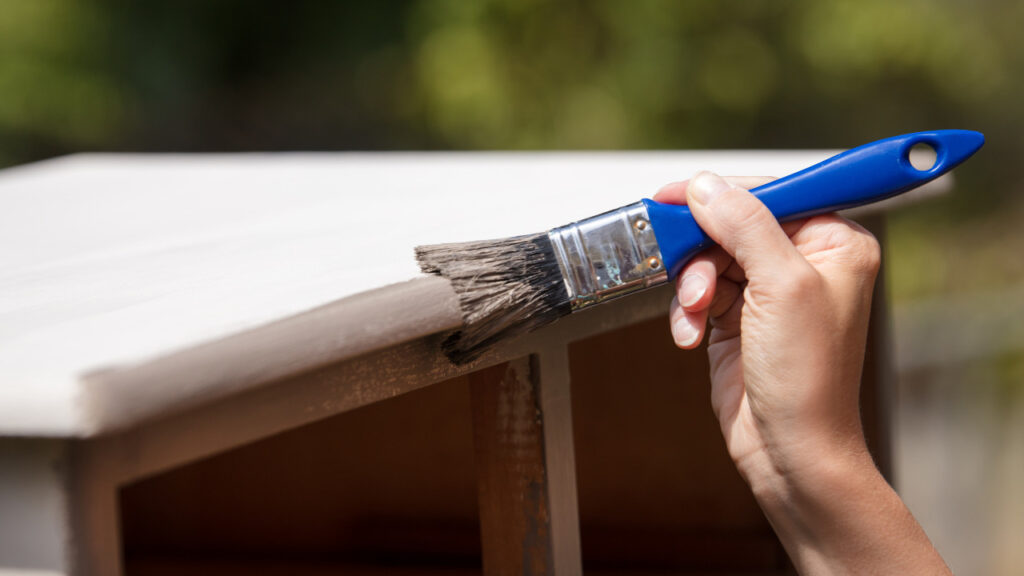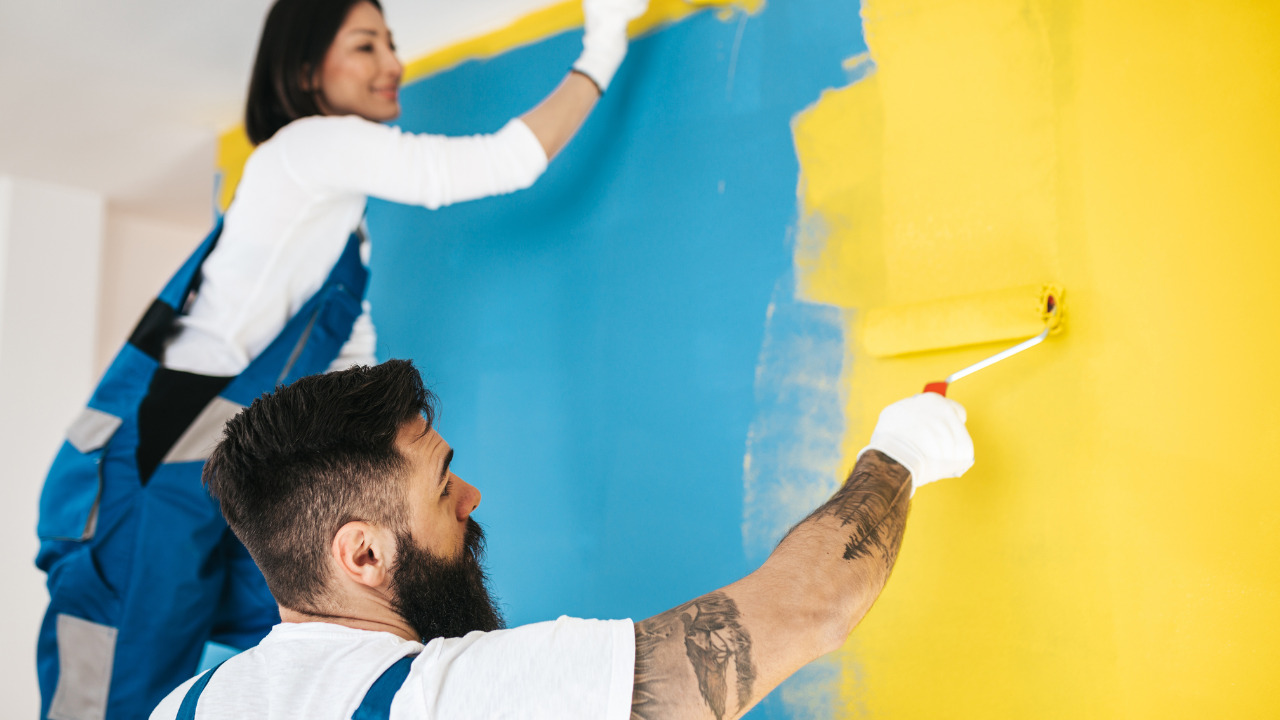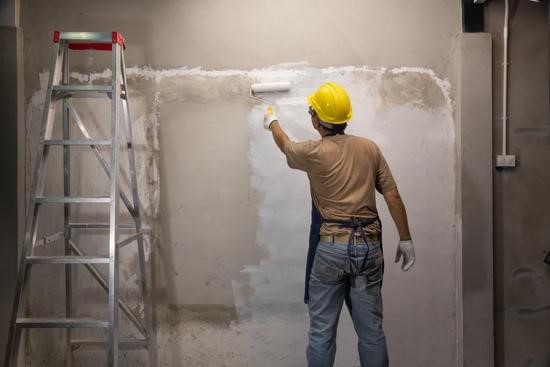Chalk paint vs. milk paint is the ultimate debate for DIY paint enthusiasts. What is milk paint? What is chalk paint? Which one is better for painting furniture or kitchen cabinets? It’s an often-debated topic that people looking for a decorative finish usually ask.
Both chalk paint and milk paint have unique textures, and a matte-like satin finish, and can create a distressed, vintage look for the furniture pieces. However, these two paint types have a lot of differences when it comes to choosing one.
Whether you are wondering about using ‘milk paint vs. chalk paint for furniture’ or chalk paint vs. milk paint for kitchen cabinets, we have got you covered. Let’s find out everything you need to know about chalk paint vs. milk paint in detail.
Table of Contents
What is Chalk Paint?
Traditional chalk paint was developed in 1990 by British color expert and artist Annie Sloan. Since then, it has garnered attention for its mate chalky texture. Unlike most milk paint, the chalky paint comes in liquid form, and you can use it instantly. It’s usually odor-free and takes only one hour to dry completely on the surfaces.
Chalk paint is also a bit thicker than milk paint. It requires fewer coats to complete an even paint finish.
What Do You Use Chalk Paint for?
You can use chalk paint to apply on several surfaces, such as walls, ceilings, furniture, and even decor items. It has a thick consistency which prevents any underlying textures from showing through.
You can give the furniture surface a matte finish or distress the piece for a vintage look.
Pros of Chalk Paint
- It’s a pre-made solution, you don’t need much preparation before painting
- It has no odor
- It dries within an hour or sometimes takes even less
- It provides thicker coats for an even paint job
- You can paint over chalk paint
Cons of Chalk Paint
- The thicker solution can mask the underlying texture
- You can only mix pre-made chalk paint shades so color customization is difficult
- Not all chalk paints are non-toxic, some may contain low amounts of volatile organic compounds
What is Milk Paint?
Milk paint has a more ancient past, as you can find its roots dating back to ancient cave times. The first human cave paintings show a similar connection to the milk paint.
The main ingredients of milk paint are milk or quark, and lime. It mostly comes in powder form, and you need to mix it with water to make a liquid paste.
Milk paint has a slight sheen. You have the advantage of altering the milk paint’s color by combining it with colored, dry pigments in the base paint.
It is one of the most environmentally friendly forms of paint because it is water-based, non-toxic, and free of volatile organic compounds.
What Do You Use Milk Paint for?
You can use milk paint on several surfaces. Walls, ceilings, furniture, and decorative items such as vases, jars, you name it, and milk paint can do the job.
As the name implies, milk paint has a milky appearance. It makes it perfect for a paint wash, for thinning out other paint, or for achieving a rustic, vintage, old paint look.
Many DIY paint enthusiasts use milk paint to achieve an antique-inspired, shabby-chic look.
Pros of Milk Paint
- Milk paint is eco-friendly and contains no toxins
- It is perfect for a chippy, shabby-chic, and antique look for furniture pieces and other surfaces
- You can create unique colors by mixing paint pigments in the liquid paint base
- It can dry fast
Cons of Milk Paint
- Milk paint is thinner than most paints, so you may need to apply multiple coats depending on the look you want to achieve
- Milk paint can have a lumpy consistency when you mix it from powder form
- Milk paint can have a very short shelf-life due to the presence of organic compounds. It usually can survive for two days if no additives are present
Chalk Paint Vs. Milk Paint: Which is Better?
The choice of chalk paint vs. milk paint depends completely on the kind of effect you are expecting from the paint job. It also depends on the color you want to produce.
Milk paint works better as a paint wash. It can do a good job of thinning paint and achieving a rustic effect with a very light sheen. Don’t forget, you can mix it with any color pigment you want, so that’s a bonus.
Chalk paint, on the other hand, can create a thicker, more even finish with a complete matte look. You can paint with chalk paint like a pro to create a realistic antique look by distressing the surface. However, color options and colors are limited.
Milk Paint vs. Chalk Paint for Furniture
Both milk paint and chalk paint are good choices to transform your wooden furniture into eye-catching vintage pieces. So, deciding whether to use chalk paint or milk paint for furniture depends on what kind of look you want to create.
Milk paint is thinner than chalky paint, so you can use one or two coats to give furniture a washed look. If your furniture has an attractive wood grain, you can use this way to highlight the piece. If you want a more opaque finish, you can apply more coats of milk paint. However, let the paint dry between each coat.
Milk paint is highly durable, so you can just paint the piece without using the sealant. You won’t need to replace the paint for years, and the color will stay beautifully vibrant.
However, milk paint dries to a hard finish, so it will be challenging to sand or chip it away. Try sanding the furniture before the milk paint dries completely.
You can easily create a chippy look with milk paint, but you will need to do a little more effort to work with chalky paint. Chalky paint distresses beautifully with just a hint of sanding. It’s easy to make carved details or wood grain on the furniture pieces with chalky paint. This paint can also give a smooth, even coverage.
However, if your painted furniture will be something that gets touched a lot, you will need to apply a wax sealant coat over chalk-style paint to protect it.

Chalk Paint vs. milk Paint for Kitchen Cabinets
Since cabinet doors are something that will frequently be moved and touched, you need paint that can handle a lot of use.
If our kitchen has a farmhouse, vintage look, both milk paint and chalk paint will look good for your kitchen cabinets.
However, milk paint has a slight advantage over chalk paint, because it has more durability. Chalk paint on kitchen cabinets will look great at first. However, it won’t be long before it starts to show some wear and tear. If you use chalk paint on cabinet doors, you most probably will need to apply a finishing wax topcoat.
This will make the chalk paint last longer but the paint finish won’t look perfectly matte on the surface. The wax topcoat will need to be refreshed periodically.
Milk paint is a better choice for cabinet doors. You will get a matte finish with just a slight sheen. You will also have the bonus of durability.

What Should You Choose?
To conclude, milk paint and chalk paint are great at what they do, with slight differences. Deciding what you need to choose depends on your project and the look you are going for.





